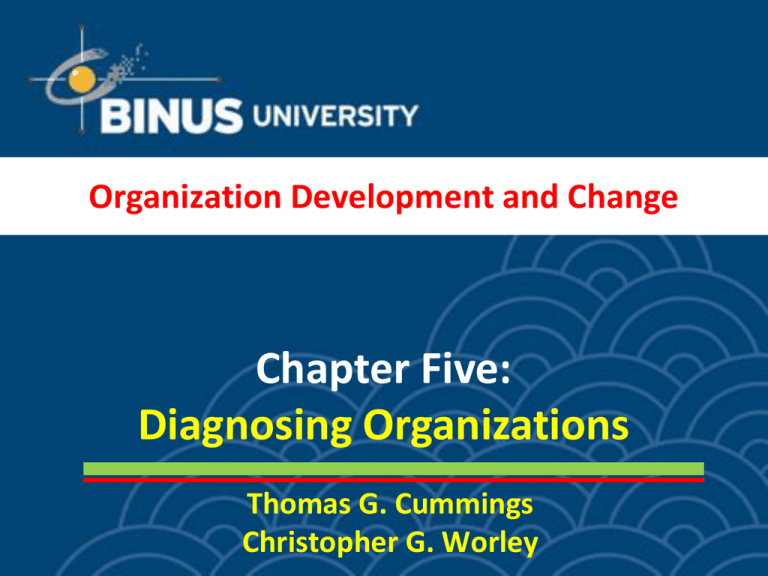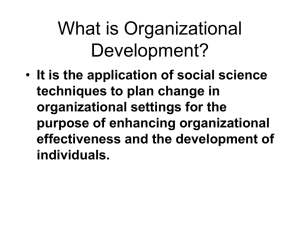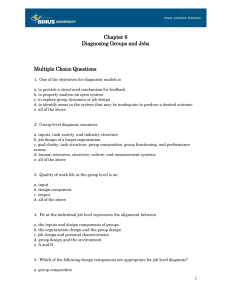Chapter Five: Diagnosing Organizations Organization Development and Change Thomas G. Cummings
advertisement

Organization Development and Change Chapter Five: Diagnosing Organizations Thomas G. Cummings Christopher G. Worley Learning Objectives for Chapter Five To equip students with a general framework of OD diagnostic tools from a systematic perspective To define diagnosis and to explain how the diagnostic process provides a practical understanding of problems at the organizational level of analysis 5-2 Diagnosis Defined Diagnosis is a collaborative process between organizational members and the OD consultant to collect pertinent information, analyze it, and draw conclusions for action planning and intervention. 5-3 Open Systems Model Environment Inputs Information Energy People Transformations • Social Component • Technological Component Outputs Goods Services Ideas Feedback 5-4 Properties of Systems Inputs, Transformations, and Outputs Boundaries Feedback Equifinality Alignment 5-5 Diagnosing Organizational Systems The key to effective diagnosis is… Know what to look for at each organizational level Recognize how the levels affect each other 5-6 Organization-Level Diagnostic Model Design Components Inputs Outputs Technology Industry Structure Strategy HR Systems Structure Measurement Systems Organization Effectiveness General Environment 5-7 Key Alignment Questions Do the Design Components fit with the Inputs? Are the Design Components internally consistent? Do they fit and mutually support each other? 5-8 Organization Environments and Inputs Environmental Types General Environment Task Environment and Industry Structure Rate of Change and Complexity Enacted Environment Environmental Dimensions Information Uncertainty Resource Dependency 5-9 Organization Design Components Strategy the way an organization uses its resources (human, economic, or technical) to gain and sustain a competitive advantage Technology the way an organization converts inputs into products and services Structure how attention and resources are focused on task accomplishment 5-10 Organization Design Components Human Resource Systems the mechanisms for selecting, developing, appraising, and rewarding organization members Measurement Systems methods of gathering, assessing, and disseminating information on the activities of groups and individuals in organizations 5-11 Organization Design Components Organization Culture The basic assumptions, values, and norms shared by organization members Represents both an “outcome” of organization design and a “foundation” or “constraint” to change 5-12 Outputs Organization Performance e.g., profits, profitability, stock price Productivity e.g., cost/employee, cost/unit, error rates, quality Stakeholder Satisfaction e.g., market share, employee satisfaction, regulation compliance 5-13 Alignment Diagnosis involves understanding each of the parts in the model and then assessing how the elements of the strategic orientation align with each other and with the inputs. Organization effectiveness is likely to be high when there is good alignment. 5-14 2-15







![[CH05] Estimasi Usaha dalam Proyek](http://s2.studylib.net/store/data/014618631_1-49924f60adc6d9c12ebc1ef87a169f34-300x300.png)



